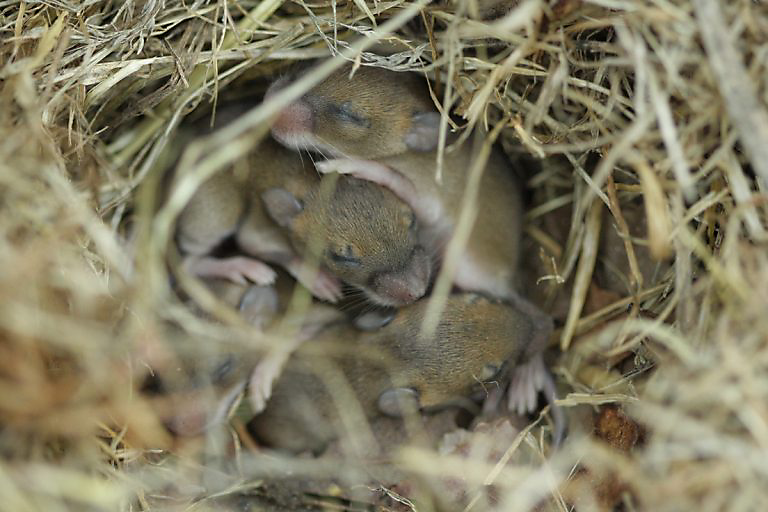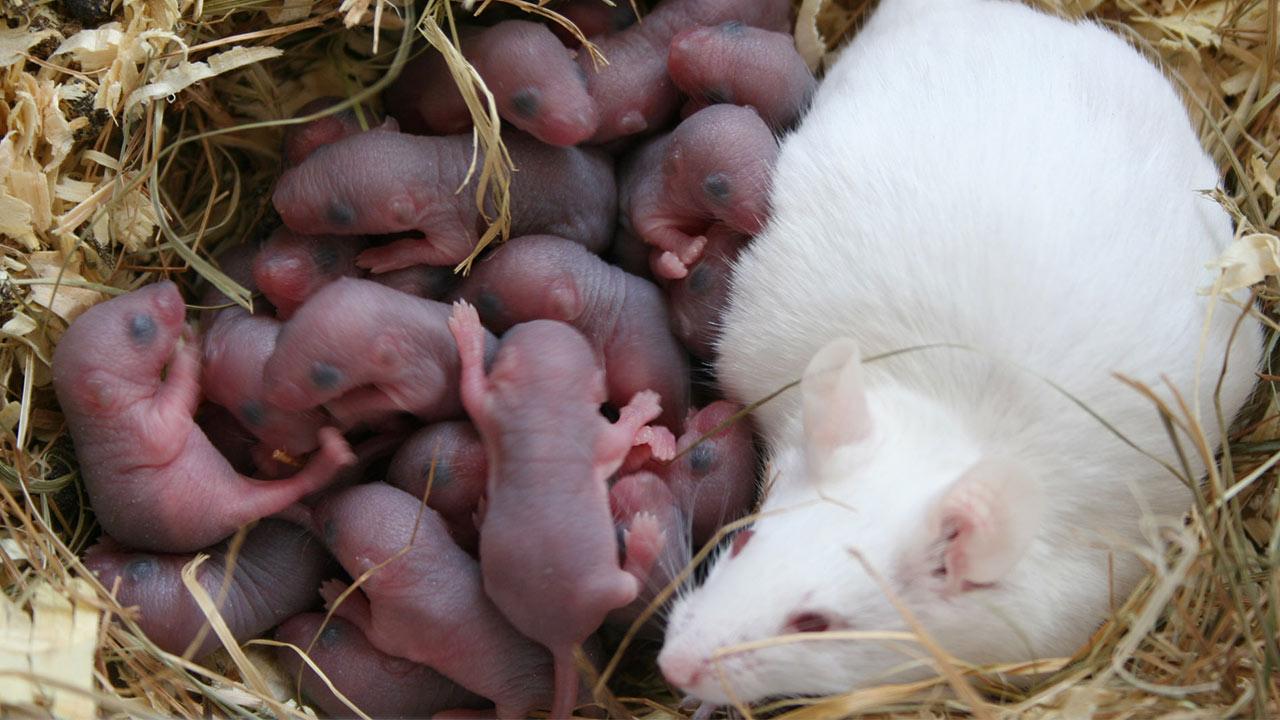Despite the best care we can provide to our mouse breeding colonies, reducing stressors, offering optimized diets, some strains of mice will fail at successfully producing a healthy litter of pups (for more information, see our article Breeding Laboratory Mice). Most of the time, this poor breeding performance is due to genetics and specific mutations that makes mating, pregnancy or lactation impossible. In those cases, there are techniques available that can be helpful in overcoming such issues.
In some transgenic strains, the mutation might lead to physical disabilities such as obesity in B6.V-Lepob/J or severe muscle weakness in C57BL/6J-GarsNmf249/J rendering breeding very difficult. However, the ovaries and oocytes of those females are viable and functioning properly. Ovarian transplant is a technique where the “mutant” ovaries are transplanted into ovariectomized “wild” females (normal and healthy females who have had their ovaries removed), who can then carry on with the mating, pregnancy and production of mutant or transgenic animals (1)
It is important to choose a recipient strain that is distinguishable from the donor strain in appearance, so that if some residual ovaries form the recipient are left behind and produce pups, those can be easily identified. One easy solution is to choose a different coat color, using white recipient for black donor for example.

Some supplements such as Omega-3 contained in DietGel® Prenatal can help reproduction of both males and females (2). However, for one reason or another, sometimes the males are unable to mate and get a female pregnant. In that case, in vitro fertilization can help. This technique involves taking oocytes from super-ovulated females and fertilize them in a dish with fresh or frozen sperm. The embryos are then grown to 2-cells and transferred in to a pseudo-pregnant female (recipient females that have been prepared by sterile mating with vasectomized males) (3)
When creating new mouse models, such as with the CRISPR technologies for example, only a few mice are produced and are very precious, being so unique and expensive. Using IVF, you can expand the colony very rapidly from just a few mice available. This technique is also useful to rescue a colony with only a few members left, to obtain a large cohort or age matched pups for studies, or to clean a strain that has been infected by viruses or pathogens. The embryos can be frozen for future use.
Another challenge can be with mouse strains that produce litters regularly but the females exhibit poor mothering ability and fail to feed or properly take care of the pups once born. In those cases, transferring the pups to a foster female within 48 hours can be a successful, low cost approach to saving the pups. When using this technique, plan to breed your foster females at the same time as your strain of interest and identify a female that has pups within 1-2 days of the pups to foster. Remove as many natural pups as you want to add fosterlings in order to keep the litter manageable for the foster mom. Gently combine the foster pups with the natural pups and their dirty litter in order to transfer the foster mother’s scent to encourage acceptance. Choose a strain that is a different color than your strain of interest to better differentiate the natural pups and the fosterlings. Removing all natural pups isn’t recommended as that could increase the risk of rejection of the pups. Swiss or BALB/c are good caring strains, and make wonderful foster mothers. If the foster female has gathered all the pups together after a few hours, she has adopted them, and will likely take care of them properly to weaning.
For more information on breeding colony management, download our Best Practices for Rodent Colony Planning, Breeding Support, and Pup Health Guide. To try our products first hand, Request a Sample.
(1) Mouse Ovary Transplantation - Behringer R., Cold Spring Harb Protoc. 2017 PMID 28250216
(2) Effect of different dietary omega-3/omega-6 fatty acid ratios on reproduction in male rats - Yan et al. Lipids in Health and Disease 2013 PMID 23497018
(3) In Vitro Fertilization in Mice - Taft R. Cold Spring Harb Protoc. 2017 PMID 29093204
Ovarian Transplant to Circumvent Difficult Breeding
In some transgenic strains, the mutation might lead to physical disabilities such as obesity in B6.V-Lepob/J or severe muscle weakness in C57BL/6J-GarsNmf249/J rendering breeding very difficult. However, the ovaries and oocytes of those females are viable and functioning properly. Ovarian transplant is a technique where the “mutant” ovaries are transplanted into ovariectomized “wild” females (normal and healthy females who have had their ovaries removed), who can then carry on with the mating, pregnancy and production of mutant or transgenic animals (1)
It is important to choose a recipient strain that is distinguishable from the donor strain in appearance, so that if some residual ovaries form the recipient are left behind and produce pups, those can be easily identified. One easy solution is to choose a different coat color, using white recipient for black donor for example.

In Vitro Fertilization and Embryos Transfer
Some supplements such as Omega-3 contained in DietGel® Prenatal can help reproduction of both males and females (2). However, for one reason or another, sometimes the males are unable to mate and get a female pregnant. In that case, in vitro fertilization can help. This technique involves taking oocytes from super-ovulated females and fertilize them in a dish with fresh or frozen sperm. The embryos are then grown to 2-cells and transferred in to a pseudo-pregnant female (recipient females that have been prepared by sterile mating with vasectomized males) (3)
When creating new mouse models, such as with the CRISPR technologies for example, only a few mice are produced and are very precious, being so unique and expensive. Using IVF, you can expand the colony very rapidly from just a few mice available. This technique is also useful to rescue a colony with only a few members left, to obtain a large cohort or age matched pups for studies, or to clean a strain that has been infected by viruses or pathogens. The embryos can be frozen for future use.
Fostering
Another challenge can be with mouse strains that produce litters regularly but the females exhibit poor mothering ability and fail to feed or properly take care of the pups once born. In those cases, transferring the pups to a foster female within 48 hours can be a successful, low cost approach to saving the pups. When using this technique, plan to breed your foster females at the same time as your strain of interest and identify a female that has pups within 1-2 days of the pups to foster. Remove as many natural pups as you want to add fosterlings in order to keep the litter manageable for the foster mom. Gently combine the foster pups with the natural pups and their dirty litter in order to transfer the foster mother’s scent to encourage acceptance. Choose a strain that is a different color than your strain of interest to better differentiate the natural pups and the fosterlings. Removing all natural pups isn’t recommended as that could increase the risk of rejection of the pups. Swiss or BALB/c are good caring strains, and make wonderful foster mothers. If the foster female has gathered all the pups together after a few hours, she has adopted them, and will likely take care of them properly to weaning.
For more information on breeding colony management, download our Best Practices for Rodent Colony Planning, Breeding Support, and Pup Health Guide. To try our products first hand, Request a Sample.
References:
(1) Mouse Ovary Transplantation - Behringer R., Cold Spring Harb Protoc. 2017 PMID 28250216
(2) Effect of different dietary omega-3/omega-6 fatty acid ratios on reproduction in male rats - Yan et al. Lipids in Health and Disease 2013 PMID 23497018
(3) In Vitro Fertilization in Mice - Taft R. Cold Spring Harb Protoc. 2017 PMID 29093204




Leave a comment
All comments are moderated before being published.
This site is protected by hCaptcha and the hCaptcha Privacy Policy and Terms of Service apply.